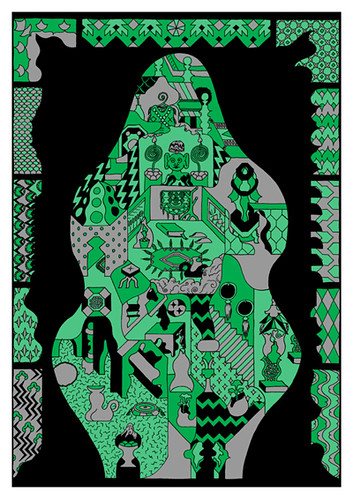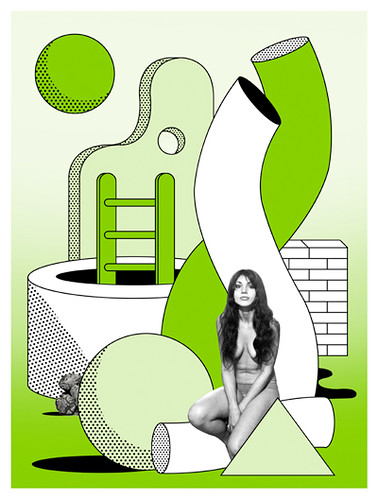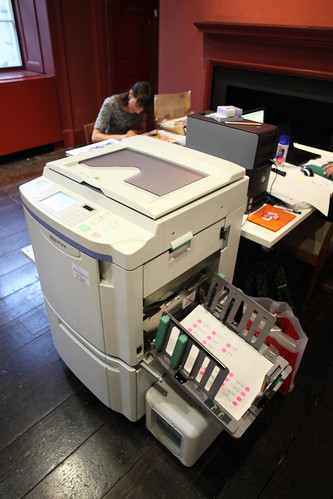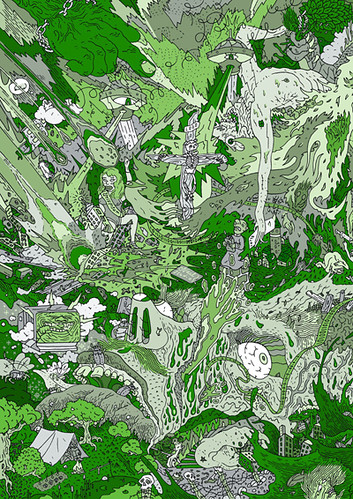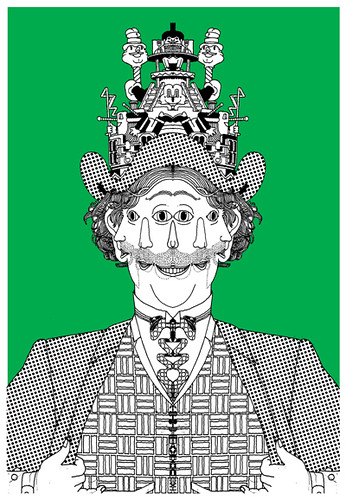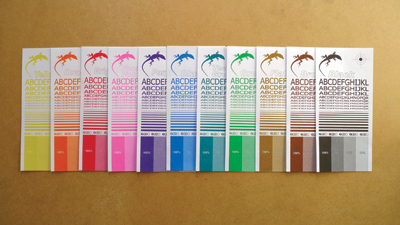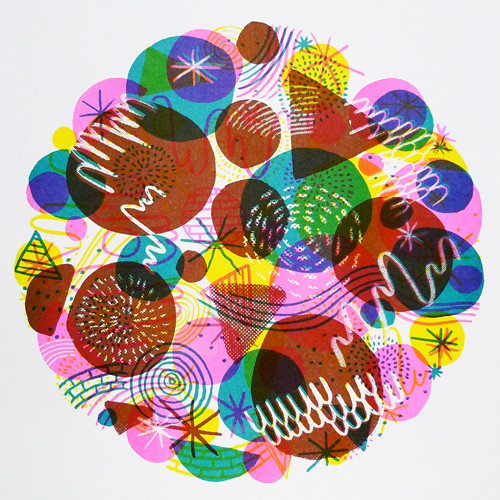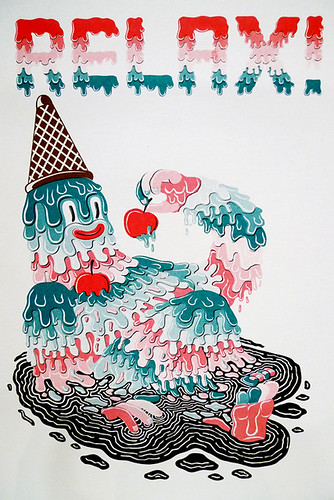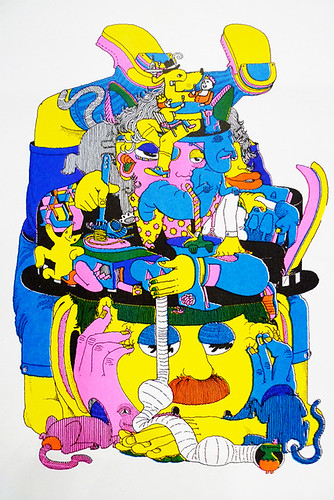Wednesday, 9:27am
28 April 2010
House of the Risograph
Landfill Editions: instant art and design with repurposed technology
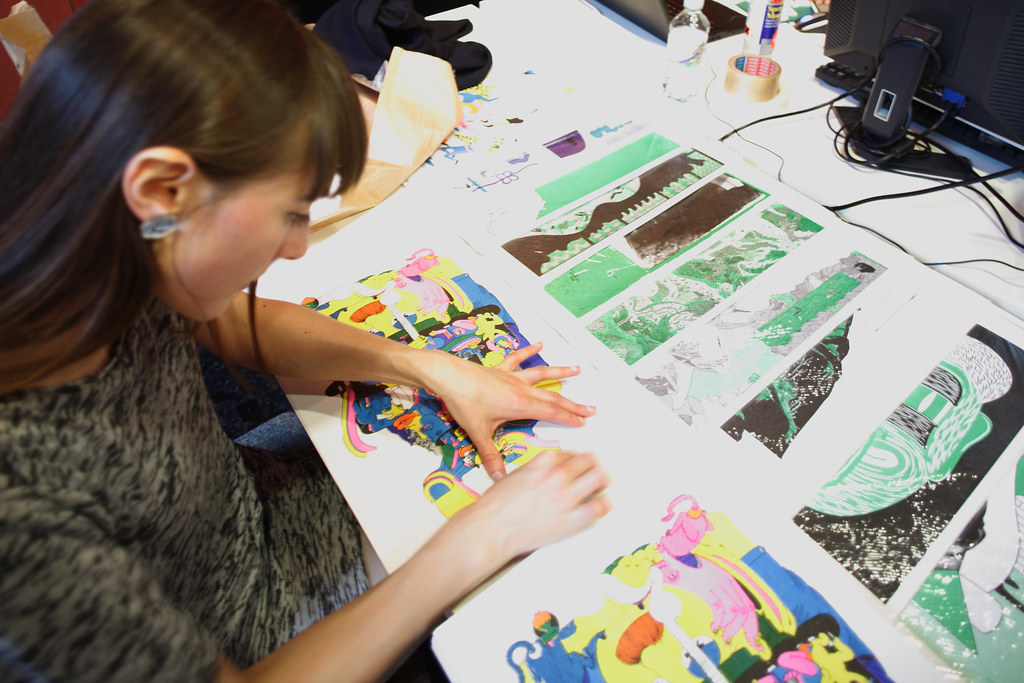
Meanwhile, over at the ‘Pick Me Up’ event currently rocking Somerset House, in one of the high ceilinged, wood-panelled rooms off the vaulted gallery, Landfill Editions have installed their new / old gadget, a Risograph machine, a piece of almost obsolete office equipment that’s been repurposed to make nearly instant art, writes Liz Farrelly.
Above: Colin Henderson’s green and black print from Fundraiser Print Series no. 1.
Landfill Editions is a small-scale arts publisher, based in London, making prints, comics and zines, to sell online and at publishing fairs. Sister company, Manymono, offers a print service, also using the Risograph machine. Founder Hugh Frost bought the gadget, which looks like a hefty-sized photocopier, on eBay.
Frost explains why; ‘I had used an online “PDF to physical print” service but was disappointed by the quality of the end product, so I turned to Risography as a way to take control of the publishing process’.
Above: Scott Barry, from Fundraiser Print Series no. 1.
Most commonly used for single-colour, low-cost, high-volume print jobs, such as fliers and hand-bills, the Risograph is bit of a hybrid, a mechanised silkscreen process combined with spot colour off-set; unlike a photocopier, it uses ‘real’ ink and therefore doesn’t utilize heat to ‘fix’ the image. Confused? Here’s the technical stuff; a thermal imaging head burns holes in a thin plastic ‘master’, which then wraps around a colour drum. Paper passes beneath at high speed, ink is pushed through the master onto the paper. You can refill the drums with ink tubes; or switch colour drums to add a different colour, simply by passing the paper through the machine again.
Below: The Risograph, just installed in Landfill Editions’ temporary studio at Somerset House.
The whole process is automatic, produces thousands of prints an hour, either from an original placed on the glass top (just like a photocopier), or from a digital file. It’s not designed for intricate, multicoloured work though, as ink may build up on the rollers and smudge; so, rather than presenting a perfect reproduction, the Risograph offers an aesthetic all its own. (Incidentally, Ditto Press also uses a Risograph, see Chloë King’s Eye blog ‘Ditto – hard copy’).
Above: Tommi Musturi, from Fundraiser Print Series no. 1.
After buying the machine, though, Hugh discovered that getting hold of the full range of colour drums wasn’t going to be easy, as ‘they’re passed around a hidden network of printers’. So, Landfill Editions launched using just one colour drum, offering up green ink, and quite a vivid pea green at that.
Above: Jim Stoten, from Fundraiser Print Series no. 1.
‘We released our first series of prints by ten artists to raise money for more colour drums; Riso’s standard UK eighteen-colour palette includes flat gold and fluorescent pink,’ explains Hugh. Stacked against the wall of the temporary studio are boxes containing pristine colour drums. ‘I’ve got a good range of colours now, but getting the rest has become pretty much an obsession,’ he adds.
Below: A selection of the instructional colour charts, from the UK colour selection for the Risograph.
Apart from the colour range, more restrictions apply. ‘I sometimes wish the Riso made prints bigger than A3 and that printing multi-coloured, double-sided on thicker stock wasn’t such a headache. But having the machine available to experiment with, being able to overprint inks, and vary the hues, negates most restrains. The Risograph may be used by DIY ziners, but it’s hardly lo-fi; it prints 600 dpi!’
Above: Mike Perry contributes his exuberant mark-making to the new print series, launched at Somerset House.
‘Recognising the framework that you’re working within is freedom,’ he adds. ‘When working on a new series of prints, we set an open brief to our invited artists, with the only restrictions being the ones inherent in the print process. And, knowing that you can afford to produce 100 copies of a three-colour, twenty-page comic for a fraction of the cost of litho and with much nicer tactile qualities than laser printing is an encouraging start point for a project, especially if you want to make personal work in large quantities.’
Above: Adrian Fleet’s new print is on show at ‘Pick Me Up’.
Debuting at ‘Pick Me Up’ are ten new prints, comics and zines; plus, each day, invited artists will print pages for another zine, to be bound and available on the last weekend of the show, coinciding with a Publish and be Damned pop-up fair (2 > 3 May).
Above: Stevie Gee’s print for Landfill Editions’ latest series.
This latest series of prints pops with intense colours, and reveals the versatility of the Risograph by featuring a wide range of graphic styles. Looking closely at the print surface, the ink sits on top of the paper; images marry jewel-like colour zones, with a softer-edged line. Mixing precision and imperfection, this method offers an alternative to the sophistication of high-quality, ink-jet giclée, and the flat clarity of screen-printing. While roaming the rooms of Pick Me Up, you may take the opportunity to ‘compare and contrast’, as just down the corridor, Print Club London are busy screen-printing, and Somerset House has produced an exclusive set of prints, from contributing graphic artists, on sale in the ‘Take Me Home’ gallery on the ground floor. (See ‘West End boys and girls’ on the Eye blog.)
Above: Jim Stoten’s second print for Landfill Editions demonstrates the Risograph’s multi-coloured possibilities.
Making stuff to sell is part of the plan, and one of the motivations behind Hugh’s project. Making personal projects available at affordable prices is how many designers and illustrators are going beyond the usual commission-based work practices to engage directly with an audience. Taking back the means of production from high-tech professional printers or on-line ‘pdf to print services’, which are expensive, complex and impersonal, allows direct, hands-on experimentation. Messing around with a Risograph is one way to do that, without sacrificing the advantages of scale.
> 3 May 2010
Pick Me Up: Contemporary Graphic Art Fair at Somerset House
Embankment Galleries, South Wing,
Somerset House, Strand, London WC2R 1LA
www.somersethouse.org.uk/pickmeup
Eye, the international review of graphic design, is a quarterly journal you can read like a magazine and collect like a book. It’s available from all good design bookshops and at the online Eye shop, where you can order subscriptions, single issues and classic collections of themed back issues.

